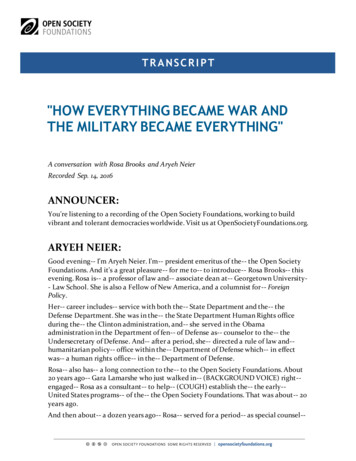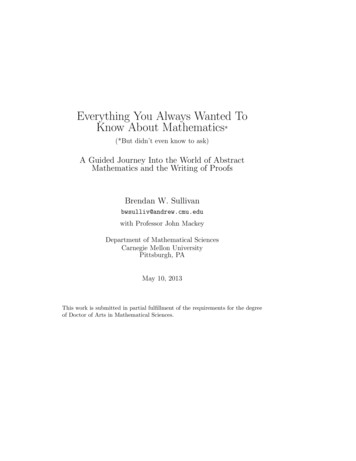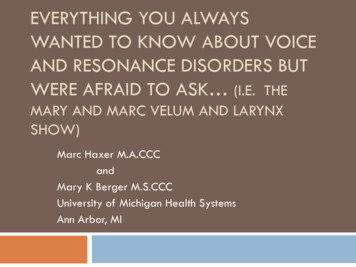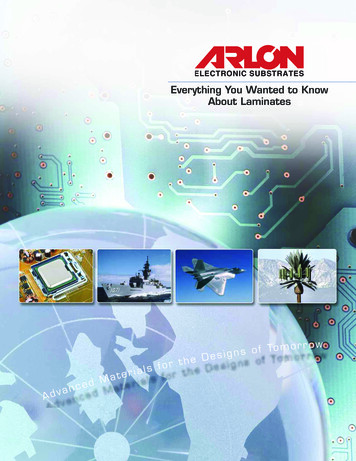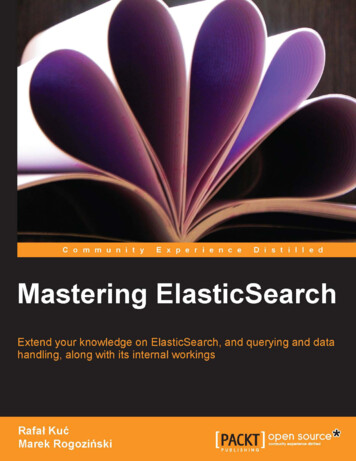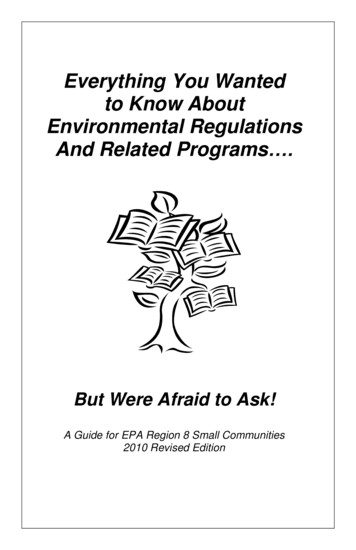
Transcription
Everything You Wantedto Know AboutEnvironmental RegulationsAnd Related Programs .But Were Afraid to Ask!A Guide for EPA Region 8 Small Communities2010 Revised Edition
PrefaceThis handbook was prepared by Region 8 Environmental Protection Agency(EPA) with small units of local government (communities) in mind. Thehandbook was prepared for use by officials of such communities as a quickreference to information on environmental regulations, related programs andassociated issues facing their constituencies. Information presented in thishandbook is meant only as a summary of basic environmental requirementsand/or EPA guidance. It is not intended to serve as a definitive statement of thespecific ways in which a community can ensure environmental compliance.Rather, it is a quick guide to the environmental regulatory and associatedprograms that typically apply to most small communities.The requirements and guidance described in this handbook are based on federalregulations and/or guidance documents in place in the fall of 2010. It should beexpected that some of these requirements and associated guidance documentswill change in the future. In addition to the federal requirements described here,states and Indian tribes can adopt rules that may be different and, in somecases, more stringent than the federal rules. Be sure to ask for and read therules from the appropriate agency in your area.This handbook is intended only as a reference source. The statutory provisionsand regulations described in this document contain legally binding requirementbut this document does not itself create any legal rights, benefits, or obligations.EPA may deviate from any approach described in this document in a given caseif consistent with legal requirements.If your community is larger than 5,000 people, you will need, at a minimum, tocomply with the environmental regulatory requirements outlined in this guide. Itis likely that a larger community will need to meet additional requirements.Information on these requirements can be obtained from EPA or your stateregulatory agency.This handbook was originally developed by the Region 8 Small Community WorkGroup in association with the Midwest Assistance Program during the 1990s.The agencies and organizations represented on the original work group included:American Water Works Association; Colorado Department of Local Affairs;Colorado Department of Public Health & Environment; City of Fort Lupton, CO;Department of Health and Human Services, Indian Health Services; NationalEnvironmental Training Center for Small Communities; North Dakota Departmentof Health; Rural Community Assistance Corporation; South Dakota Departmentof Environment & Natural Resources; US Department of Agriculture, RuralDevelopment; US EPA Region 8; US EPA Headquarters, Washington DC; UtahDepartment of Environmental Quality and Wyoming Casper CollegeEnvironmental Training Center. It was updated by EPA Region 8 in 1991, 1993and 1999 under the direction of the Region 8 Small Community Coordinator.This 2010 edition was a joint effort of EPA Region 8 staff.
Table of ContentsAir ProgramsAir Quality Standards and EPA’s Ambient Air Monitoring Network .1Air Toxics or Hazardous Air Pollutants .2Clean Air Act Permits.3Mobile Sources and Related Programs .4Radiation and Uranium .6Indoor Environments .7Radon . 7Environmental Tobacco Smoke (ETS) . 7Indoor Air Pollution & Schools . 8Land ProgramsHazardous Waste .10Municipal Solid Waste.14Subtitle D Municipal Solid Waste Landfill Regulations . 14Reuse and Recycling . 15Underground Storage Tanks .17Superfund .19Brownfields .21Water ProgramsDrinking Water. 23National Primary Drinking Water Regulations and Federal MonitoringRequirements. 23Maximum Contaminant and Maximum Residual Disinfectant Levels . 24Total Coliform Rule (TCR) . 25Nitrate and Nitrite . 26The Chemical Phase Rules . 26The Lead and Copper Rule . 27Radionuclides Rule . 27Disinfectants and Disinfection Byproducts Rule . 28Surface Water Treatment Rules . 29Ground Water Rule . 30Consumer Confidence Rule . 31Public Notification and the Public Notice Rule . 32Capacity Development . 33Sanitary Surveys . 34Operator Certification Program . 35Injection Wells . 37
Source Water Assessment and Protection . 40Water Quality Standards/Designated Use Waters . 42Protecting Water Bodies . 44Dredge and Fill/ Section 404 Permits . 44Nonpoint Source Pollution . 46Wastewater . 47Discharge Permits under the National Pollutant Discharge EliminationSystem (NPDES) . 47Septic (Decentralized) Systems . 48Secondary Treatment of Municipal Wastewater . 50Biosolids/Sewage Sludge Use and Disposal . 51Pretreatment Requirements . 53Stormwater . 55Clean Water State Revolving Fund Program . 57Drinking Water State Revolving Fund Program . 58Drinking Water Infrastructure Grants Tribal Set-Aside Program . 59Sustainable Water / Wastewater Infrastructure . 60Other ProgramsAsbestos .61Children’s Environmental Health .64Climate Change .66Emergency Planning & Community .67Right-to-Know Act .67 ENERGY STAR .69Environmental Justice .71Lead .73National Environmental Policy Act .76Pesticides .78Pollution Prevention .81Polychlorinated Biphenyls (PCBs) .82School Chemical Cleanout .85Tribal Assistance Program .87Abbreviations .89Glossary of Terms .91Resources.95
AIR PROGRAMSClean Air ActAir Quality Standards and EPA’s Ambient AirMonitoring NetworkThe Clean Air Act (CAA) requires EPA to set air quality standards for pollutantsconsidered harmful to public health and the environment. The main pollutants forwhich there are air quality standards include ozone, particulate matter, sulfurdioxide, nitrogen dioxide, carbon monoxide and lead.EPA has established a network of ambient air quality monitors for use inmeasuring levels of these pollutants in the air. EPA then uses this information todetermine which areas of the country are attaining the air quality standards andwhich areas are not. The monitor information is also used to inform the public ona near real-time basis about the current air quality in their local area. Thisinformation is especially important to those living in areas that do not attain oneor more of the air quality standards or those with health concerns that make themsensitive to air pollution.Additional InformationEPA maintains large databases to store the air quality data from the monitoringnetwork. The public can access this information in a number of different ways byutilizing the websites described below:AIRNow – Obtaining air quality information is important for planningdaily outdoor activities, especially for those who are sensitive to airpollution. AIRNow website provides maps of current air qualityconditions and next day forecasts for hundreds of cities nationwide.http://www.airnow.govAirCompare – One of the most common questions received by EPArelated to air quality is ―How does the air quality in my city compare withother cities?‖ The AirCompare tool allows users to answer this questionand find other information like ―What time of year has the best airquality?‖ and ―Is air quality improving in my area?‖ This information canhelp people make informed decisions about moving or er – This website provides a collection of air quality analysistools for those seeking a more technical view of air quality monitoringdata. Users can generate maps and graphs for the pollutants and timethey specify.http://www.epa.gov/airexplorer1
AIR PROGRAMSClean Air ActAir Toxics or Hazardous Air PollutantsAir toxics, also known as hazardous air pollutants (HAPs), are pollutants that areknown or suspected to cause serious health effects such as cancer, birth defects,and respiratory, reproductive, or neurological effects. EPA is working with state,local, and tribal governments to reduce the release of air toxics to communitiesand the environment. CAA lists 187 known HAPs. Examples of HAPs and theirsources include benzene (gasoline), perchlorethlyene (some dry cleaners), andformaldehyde (many industries). Other listed HAPs include acrolein, dioxin,asbestos, toluene, and metals such as manganese, mercury, chromium, andlead compounds.Under Section 112 of the CAA, EPA has issued over 130 rules affecting industrialsources, such as cement plants, oil refineries, oil and gas exploration, and woodfurniture manufacturing, as well as categories of smaller sources, such as drycleaners, auto body refinishing, gas stations, and chromium electroplatingfacilities. These rules are expected to reduce air toxics emissions each year byabout 1.7 million tons. For more information about these rules go to:http:// www.epa.gov/ttn/atw/eparules.htmlAccording to the National Air Toxics Assessment, the majority of air toxics areemitted from ―mobile sources.‖ These include on-road sources such as cars,buses and trucks and non-road sources such as trains, airplanes, ships andconstruction equipment.Additional InformationImproving Air Quality in Your Community - Communities like yours areessential to protecting our environment and improving public health.The following website provides ideas on what communities can do toimprove local air quality. http://www.epa.gov/air/community/Basic Air Toxics Information - This webpage provides basic informationrelated to air toxics, health, and ecological effects through the use ofquestions and .htmlHealthy Air: A Community and Business Leaders Guide is a collection ofnon-regulatory, time-and-cost-saving ideas communities can use toreduce toxic air pollution. You can request a copy by calling (919)5415514 and asking for document number EPA-453/B-05/001 or go .htmlThe Community Toolbox - http://ctb.ku.edu/en/default.aspxHealth Effects Notebook for Hazardous Air Pollutants 2
AIR PROGRAMSClean Air ActClean Air Act PermitsCongress established the New Source Review (NSR) permitting program, alsoknown as pre-construction permitting, as part of the 1977 CAA amendments.Congress established the Operating Permits program as part of Title V of the1990 CAA amendments. Most NSR permits and Operating Permits are issuedby state or local air pollution control agencies. EPA is responsible for overseeingthese programs. On Indian reservations, EPA issues the permits, unless EPAhas delegated responsibility to the Indian tribe.The purpose of NSR is to ensure that air quality is not significantly degraded fromthe addition of new and modified stationary sources of air pollution. In areas withunhealthy air, NSR helps ensure that new emissions do not slow progress towardcleaner air. The NSR program also helps ensure that any large new or modifiedindustrial source in your neighborhood will be as clean as possible, and thatadvances in pollution control occur concurrent with industrial expansion.NSR permits are legal documents that the facility owner/operator must abide by.The permit specifies what construction is allowed, what emission limits must bemet, and often how the emissions source must be operated.The purpose of Operating Permits is to improve compliance by consolidating allCAA requirements for an existing stationary source of air pollution into onedocument. These permits are issued to all large (―major‖ sources) and a limitednumber of smaller sources. Operating Permits include pollution controlrequirements from federal or state regulations that apply to a source as well asrequirements from NSR permits that have been issued to a source.The public has an opportunity to comment on draft NSR permits and draftOperating Permits. In addition, the public may petition EPA to object to certainOperating Permits. To learn how you can comment on NSR and OperatingPermits, contact your state or local air pollution control agency, or contact theEPA regional office.Additional information NSR permits: http://www.epa.gov/nsr Operating permits: http://www.epa.gov/air/oaqps/permits EPA Region 8 Air permitting ing/index.html3
AIR PROGRAMSClean Air ActMobile Sources and Related ProgramsEPA protects public health and the environment by regulating air pollution frommotor vehicles, engines and fuels, and by encouraging travel choices thatminimize fuel consumption. These "mobile sources" include cars and lighttrucks, heavy trucks and buses, nonroad recreational vehicles (such as dirt bikesand snowmobiles), farm and construction machines, lawn and garden equipment,marine engines, aircraft, and locomotives.The EPA’s Office of Transportation and Air Quality (OTAQ) has the primaryresponsibility for developing the necessary requirements, regulations, andstandards. OTAQ also has direct implementation of some of the provisions,programs and rules. For example, new car/truck manufacturers must report testresults of new vehicle emissions directly to OTAQ. EPA Region 8 works directlywith our States and metropolitan planning organizations to address issues withthe development of State Implementation Plans (SIP) revisions that involveemissions of motor vehicles (e.g., motor vehicle inspection and maintenance orI/M programs, and transportation conformity determinations). The RegionalOffice and OTAQ are also a source of information for questions from citizens andregulated entities.Additional InformationOTAQ has a number of online resources for the public, including the following:Overview of Pollutants and Programs - How much air pollution, airtoxics, and greenhouse gases are emitted by mobile sources, theprograms OTAQ has undertaken to control these emissions, and theimpact of those programs on air quality and climate er Information - Learn what consumers can do to help reduceair pollution. Use the Green Vehicle Guide to find the cleanest, mostfuel-efficient vehicle.http://www.epa.gov/otaq/actions.htmOn-Road Vehicles and Engines - Information about highwayvehicles, fuel economy, emission standards and regulations, newvehicle certification and in-use vehicle compliance, inspection andmaintenance programs, diesel retrofit programs, and importing vehiclesand engines to the United States.http://www.epa.gov/otaq/hwy.htm4
AIR PROGRAMSClean Air ActNonroad Engines, Equipment and Vehicles - Information aboutaircraft, diesel boats and ships, gasoline boats and personal watercraft,nonroad diesel equipment, forklifts, generators and compressors(gasoline and propane), lawn and garden (small gasoline equipment),locomotives, and snowmobiles, dirt bikes, and ATVs: emissionstandards and regulations, certification and compliance, and dieselretrofit programs.http://www.epa.gov/nonroadFuels and Fuel Additives - Information on diesel, gasoline, renewablefuels, and alternative fuels for mobile sources, fuel-quality controlprograms, requirements for registration and health effects testing of newfuels or fuel additives, and reporting s - Information about partnerships to reduce air pollutionassociated with transportation and other mobile sources. Theseprograms include the National Clean Diesel Campaign (NCDC),SmartWay, and Clean School Bus USA.http://www.epa.gov/otaq/voluntary.htmState and Local Transportation Resources - Information on the tiesbetween land use, transportation planning, and air x.htmModeling, Testing, and Research - Information on modeling andinventories for estimating emissions from highway vehicles, nonroadsources, and fuels.http://www.epa.gov/otaq/research.htm5
AIR PROGRAMSClean Air ActRadiation and UraniumRadiation is naturally occurring and is all around us from various sources.Residents of Region 8 states often experience greater background radiationexposure as a result of the natural uranium formations and high elevations. Thenatural uranium formations also result in an increase in mining and milling ofuranium in our region; Region 8 states contain approximately 65% of the uraniumreserves in the U.S. Uranium is naturally occurring and undergoes spontaneousradioactive decay into radioactive ―daughter‖ products until a stable element isreached. One daughter of uranium is radon, a colorless, odorless radioactivegas (see page 7, Radon).To protect human health from radiation exposure, EPA regulates radioactive airemissions from various processes under the CAA. Radionuclide NationalEmission Standards for Hazardous Air Pollutants (NESHAPs), 40 CFR Part 61,regulate radon emissions from underground uranium mines and from uraniumbyproduct impoundments at uranium mills. The standards set are a result of ahuman health risk assessment conducted around 1989, the time the rules werepromulgated.Additional Information EPA’s role in radiation protection: http://www.epa.gov/radiation/ Information on Radionuclide .html Calculate your background radiation ate.html6
AIR PROGRAMSIndoor EnvironmentsIndoor EnvironmentsComparative risk studies performed by EPA and its Science Advisory Board haveconsistently ranked indoor air pollution among the top five environmental risks topublic health. Most people are aware that outdoor air pollution can be harmful totheir health but may not know that indoor air pollution can also have significanteffects. In fact, EPA studies of human exposure to air pollutants indicate thatindoor air levels of many pollutants may be 2-5 times, and sometimes 100 times,higher than outdoor levels. These levels of indoor air pollutants are of particularconcern because it is estimated that most people spend as much as 90% of theirtime indoors.RadonRadon is a radioactive gas given off by soils and rocks that seeps into buildingsand homes through foundations. You cannot see it, smell it, taste it or feel it asyou breathe it into your lungs. The U.S. Surgeon General has determined thatindoor radon is the second leading cause of lung cancer in the United States. Itis estimated that over 20,000 non-smoking persons a year get radon caused lungcancer.Congress enacted the Indoor Radon Abatement Act (RAA) in 1988, requiringEPA to fund State governments to establish local and community radonprograms encouraging testing of homes, schools and commercial buildings andmitigating for radon levels above 4 picocuries per liter (pCi/L). EPA alsoevaluates radon mitigation contractors and radon measurement labs anddeveloped a national proficiency exam to test the knowledge of radoncontractors.There are a number of options available to test for radon. Do-it-yourself radontest kits can be purchased for about 25 at hardware stores or can be ordered ata discount by calling 1-800-SOS-RADON. A certified radon tester can test yourhome, building or school with a continuous radon monitor for short and long termtesting. To find a certified radon tester near you visit http://www.neha-nrrp.org.Environmental Tobacco Smoke (ETS)Environmental tobacco smoke (ETS), or "secondhand smoke," is the mixture ofsmoke that come from the burning end of a cigarette, pipe, or cigar, and smokeexhaled by a smoker. ETS contains over 250 toxic compounds, more than 50 ofwhich can cause cancer, and many others of which are strong respiratoryirritants. The Centers for Disease Control and Prevention estimates 46,000 heartdisease deaths occur annually among nonsmokers in the US from exposure toETS. ETS impairs the respiratory health of hundreds of thousands of children,including the exacerbation and increased onset of childhood asthma.EPA is working to generate public awareness of the health risks associated withchildhood exposure to ETS in the home. As part of this public awareness work,7
AIR PROGRAMSIndoor Environmentsthe Indoor Environments Program has developed the Take the Pledge educationcampaign to encourage adults to smoke outdoors, away from children and familymembers.Indoor Air Pollution & SchoolsChildren may be especially susceptible to air pollution. The same concentrationof pollutants can result in higher body burden in children than in adults becausechildren breathe a greater volume of air relative to their body weight. For thisreason, air quality in schools is of particular concern. Good indoor air qualitycontributes to a favorable learning and working environment as well as a senseof comfort, health and well being for people in school buildings.EPA has developed a voluntary program called Indoor Air Quality Tools forSchools (IAQ TfS) to address this issue. The program offers guidance on howschool staffs can achieve and maintain good indoor air quality using low or nocost techniques. The IAQ TfS kit is available to school administrators and isintended as a "do·it·yourself" IAQ management plan. It is designed to helpprevent indoor air quality problems from occurring and to guide schools throughquick and efficient resolution of problems if and when they do occur. Theprogram focuses on both awareness and effective communication. Thisproactive approach helps schools avoid the premature spending of money on airsampling and consulting fees since many indoor air quality problems can beeasily identified and corrected without hiring professional help. IAQ TtS is avoluntary, non regulatory program. EPA's role is simply to promote good indoorair quality through education and to motivate schools to use this valuableinformation.Does the indoor environments program apply to mycommunity?Local communities, in concert with state governments, play a vital role inreducing the public health risk associated with indoor air pollution. It is very likelythat there are homes, schools and commercial buildings in your community thathave elevated indoor air pollutant concentrations.Currently, most indoor environment policies are non-regulatory. EPA, state, andlocal governments have focused their energies on educating the public about thehealth risks of indoor air pollution and encouraging voluntary actions, such astesting indoor environments for radon and implementing the IAQ TfS Action Kit.Some states have developed radon regulations that require certification of radonprofessionals, mandatory testing of all public schools and disclosure of radonconcentrations in real estate transactions. There are a limited number of statesthat have adopted legislation for indoor air quality policies in schools andcommercial buildings.8
AIR PROGRAMSIndoor EnvironmentsActions your community should be taking:Local governments can act to protect their residents from indoor air pollution inseveral ways: Develop indoor air quality education and outreach programs Adopt radon-resistant building codes for new construction, encouragingradon testing and ensuring local radon contractors are RCP listed Community education on the health risks associated with childhoodexposure to environmental tobacco smoke in the home Encourage local schools to implement the EPA's Indoor Air QualityTools for Schools Action Kit Work in conjunction with state radon and indoor air quality programsand community organizations, such as the American Lung Association,to elevate local attention to this important health risk.Additional InformationEPA has established a toll-free number to obtain indoor air quality information.For general indoor air quality inquiries and to order publications, contact EPA’sIndoor Air Hotline at (800) 438-4318.For radon inquiries, contact the Radon Hotline at (800) SOS -RADON.Many states also have staff available to answer questions regarding radon. Seethe listing for State Radon contacts in the Resource Section for this book.9
LAND PROGRAMSResource Conservation & Recovery ActHazardous WasteHazardous waste is generated by a wide variety of businesses and activities,such as oil refineries, computer semi-conductors manufactures, drycleaners andacademic laboratories. A waste is identified as hazardous if it is a solid wasterthat either exhibits one of four characteristics (ignitability, corrosivity, reactivity, ortoxicity) or it is specifically listed by EPA as hazardous in the Code of FederalRegulations (CFR). Potential dangers include explosions, fires, corrosivedestruction of materials, chemical reactions, and/or health-impairing exposure totoxic chemicals. The greater the quantity or concentration of chemicalsexhibiting any of these dangers, the greater the need to assure their propermanagement.In 1976, Congress enacted the Resource Conservation and Recovery Act(RCRA), as amendments to the Solid Waste Disposal Act of 1965. RCRA servesas the primary regulatory vehicle to assure that hazardous waste is properlymanaged, from the point of its generation to its ultimate disposal or destruction,i.e., ―from cradle to grave.‖ RCRA establishes a comprehensive set ofrequirements to define the materials that are subject to hazardous wasteregulation. While EPA was given the authority to set national standards andinitially conduct the program, most states have received authorization to managethese hazardous waste programs. The Act also describes the responsibilities ofanyone who generates, transports, stores, treats, or disposes of or otherwisemanages hazardous waste. Individual household wastes, many that may exhibitsome of the dangers described above, are exempt from federal RCRA hazardouswaste requirements. See Household Hazardous Waste Collection Programssection for additional information.In 1984, Congress enacted the Hazardous and Solid Waste Amendments(HSWA) to RCRA. These rules broadened EPA’s authority to address pastdisposal of solid wastes at active and inactive hazardous waste managementfacilities.Currently, there are three categories of hazardous waste generators under theRCRA program requirements:Large Quantity Generator (LQG) – is a facility that generates more than1,000 kilograms per month of any hazardous waste or more than onekilogram of an ―acute‖ hazardous waste. A kilogram is approximately2.
Everything You Wanted to Know About Environmental Regulations And Related Programs . But Were Afraid to Ask! A Guide for EPA Region 8 Small Communities 2010 Revised Edition . Preface This handbook was prepared by Region 8 Environmental Protection Agency
